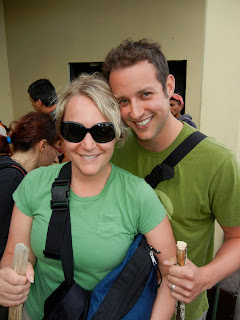Photo of a school in the pueblo Santa Maria de Jesus.
Since early December, we have been attending between four and five hours per day of one-on-one Spanish courses, studying about three or four hours after that, and studying for tests. It's been a full-time venture, but has measurably improved our Spanish. We both advanced only one level away from being prepared to take the DELE (Diplomas of Spanish as a Foreign Language) which is the official accreditation of the degree of fluency of the Spanish Language, issued and recognized by the Ministry of Education, Culture and Sport of Spain.
Aaron with his Spanish teacher at school.
Me with my Spanish teacher.
In light of all of our study here in Guatemala, it seems fitting to write a post about the general state of education in this country. Schools in Guatemala are divided into "primera" (elementary school), "secondaria" (middle school), and "escuela diversificada" (which is our equivalent of high school). Universities exist (called Universidades), but are not widely attended. "Colegio" doesn't mean "college" in Guatemala, it is actually used to refer to private schools, which are usually religiously affiliated and exist in droves throughout the country due to the state of public education. Anyone with money sends their kids to private school here.
Girls in a pueblo on the west coast of Guatemala, walking to their private "colegio"
The public school system in Guatemala has three major issues (that we've observed and talked with locals about).
1) Funding and cost
Public school is supposed to be free in Guatemala. However, just like school in the US, supplies are required and often uniforms are required. Many poor families in rural areas cannot afford these things and therefore are not permitted to attend school (unless an NGO helps them get the needed supplies. According to "Common Hope" (an NGO in the area), supplies can cost about $150 per year per child. While this may not sound like a lot to us, for a family with four to five kids who only makes an average of $2-$5 per day, this is not affordable. To top that off, funding has been cut dramatically for the public school system. We were told by several locals and NGOs that it is common to have 60 to 70 children in a classroom with one teacher. This brings me to the next problem....
2) Teacher preparation/policies
Anyone who completes "escuela diversificada" (high school) here is allowed to become a teacher in a public school system. Teaching is a common job for young women (many of whom have their own children by the time they graduate from high school...if they graduate at all). This means that classes of 60 or 70 are being handled by a young teacher who typically has never had "in the field" training and may have little experience. Teachers use a "national curriculum" to teach from, which often does not account for differences in learning styles or abilities.
The Country Director for Common Hope told us that all teachers are required to belong to a union. This sounds like a great thing, right? Unfortunately, the unions strike a couple times per year, often delaying the start of public schools each year by a few weeks. The school system has no way to make up lost time that occurs from strikes, which means that the school year here can be surprisingly short! Kids are usually in school from mid to late January until the end of September (they have October, November, December and...depending on strikes, much of January off). Unions also mean that it is virtually impossible to fire a teacher. Common Hope told us that even teachers who sexually abuse students are, at most, transferred to another district.
Furthermore, there is NO national substitute teacher system. As we learned from Common Hope, if a teacher is ill or needs to stay home to care for one of her own children, class does not occur that day. Common Hope has recently started to experiment with a substitute system in the pueblos surrounding Antigua.
3) Factors at Home
While it is clear that most families in Guatemala understand the importance of education, they are also trying to stay alive. Those who are poor and live in rural areas work making and selling crafts or in agricultural areas. Families face the choice of either sending children to school or keeping them at home to help make a little more money (so many children seem to "work" on the streets selling textiles, offering shoe shines, etc.).
Furthermore, poor nutrition from infancy through childhood (a diet of tortillas and coffee - yes, even for babies) often causes delayed or limited cognitive development in children, leading to concentration problems when they begin school. According to NGOs like Common Hope, up to 40% of guatemala children repeat first grade, primarily because of a lack of educational preparation, language barriers (e.g., class is not in their native language) and a lack of individual attention to help them learn (class sizes are so large...).
Research suggests that those who have access to education before first grade (e.g., pre-school, reading at home, etc.) are more likely to succeed in (and stay in) school. However, as the country director for Common Hope shared with us, many adults in rural areas of Guatemala are illiterate, making something as simple as reading to a child hard to do. Guatemalan children usually do not have access to pre-school, making first-grade the first exposure they have had to education.
The Guatemalan government is recognizing the problem and in 2005, they began training pre-elementary teachers. However, the lack of quality schools, particularly in rural villages, remains an overwhelming problem that needs to be tackled if the children and the communities they reside in are to thrive and the cycle of poverty is to be broken.
